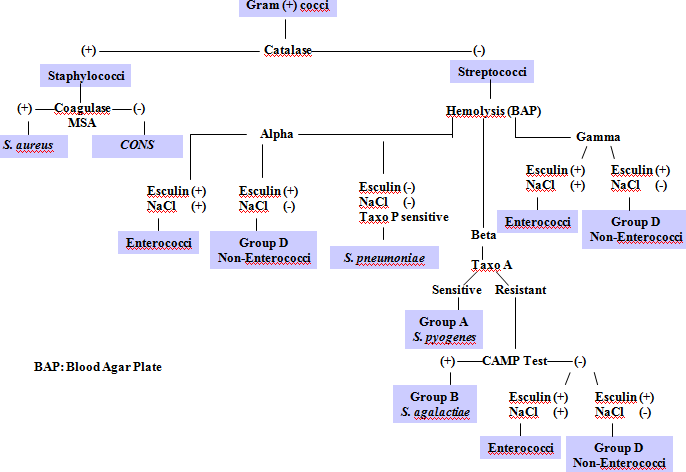Overview of Biochemical tests used to identify bacteria in Microbiology laboratory

In this blog post, i am sharing information about common, conventional biochemical tests and their primary uses in Microbiology laboratory for the identification of particular pathogen of interest. Some of the biochemical tests mentioned here for example Catalase test, Oxidase test assists us in many ways apart from the primary purpose mentioned in this post;
- Beta-glucuronidase test (MUG Test) : To identify Escherichia coli. Escherichia coli produces the enzyme beta-D-glucuronidase, which hydrolyzes beta-D-glucopyranosid-uronic derivatives to aglycons and D-glucuronic acid.

Overview of Biochemical tests for differentiating Gram positive cocci - Bacitracin Sensitivity Test: Bacitracin sensitivity test differentiates Streptococcus pyogenes(positive) from other beta hemolytic streptococci (resistant).
- Bile solubility test : To differentiate Streptococcus pneumoniae from other alpha hemolytic streptococci. Bile or a solution of a bile salt, such as sodium desoxycholate rapidly lyses pneumococcal colonies.

CAMP test :
A. Streptococcus agalactiae (positive)
B. Streptococcus pyogenes (Negative)
Image Source: ASM - CAMP Test: Certain organisms such as Streptococcus agalactiae (Group B streptococci), produce a diffusible extracellular protein (CAMP) factor that acts synergistically with the beta-lysin of Staphylococcus aureus and causes enhanced lysis of RBCs.
- Catalase test: To differentiate Staphylococci (catalase positive) from Streptococci (catalase test negative)
- Citrate utilization test: To differentiate members of Enterobacteriaceae family.
- Coagulase test: Coagualse test is used to identify Staphylococcus aureus. Coagulase test differentiates Staphylococcus aureus (positive) from coagulase negative staphylococci (CONS), such as S. epidermidis, S. saprophyticus.
- DNase test: This test is used to determine the ability of an organism to hydrolyze DNA. It is primarlly used to identify Staphylococcus aureus
- Indole test: This test is used to determine the ability of an organism to split tryptophan to form the compound indole. It is used differentiate gram negative rods particularly E. coli in microbiology laboratory.
- Litmus milk decolorization test: To help identify Enterococcus and some Clostridia which have ability to metabolize litmus milk.
- Lysine Decarboxylase test: To assist in the identification of salmonellae and shigellae
- Oxidase test: To help identify Neisseria, Pasteurella, Vibrio, Pseudomonas. This test is used to determine the presence of bacterial cytochrome oxidase.
- Urease test: Urease test is used to determine the ability of an organism to produce urease (an enzyme) which hydrolyzes urea. This test is done to help identify Proteus, Morganella, Yersinia enterocolitica, Helicobacter Pylori